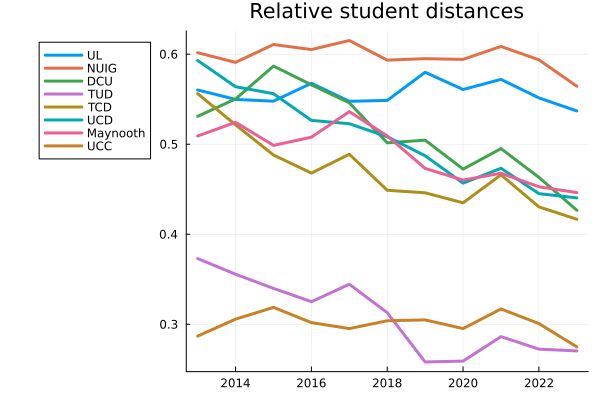Prompted by the arrival of another year’s “Feeder School” data in the Irish Times recently, I decided to update an analysis I have done in the past (Cullinan and Halpin, 2017), looking at the catchments of the several univerisities in Ireland. The picture I had from the previous analysis was that Galway, UL and UCD were most national in their recruitment patterns, TCD rather less so and UCC very markedly local.
The simplest index of catchment is the average distance students travel to college. Let the straight-line distance from their school to the university stand in for this, and we can calculate a simple student-weighted statistic for each university. Clearly, where the institution is located matters: average distance from all schools to Cork or Letterkenny (at opposite ends of the island) is less than that to Limerick, Galway or Dublin, and if we weight the average distance by the number of students, institutions in or near Greater Dublin will have a much lower value. Therefore, I present a relative distance index: the average student-weighted mean distance (for actual students) as a proportion of the average student-weighted distance for all students progressing to third level. A value of 1.0 would mean students were selecting the institution in a manner that was independent of distance; values less than 1.0 represent a student body that is disproportionately local.
In my previous analysis, the only institution with a value near 1 was the no-longer independent Church of Ireland Teacher Training College: for students who wanted this sort of training there was no alternative, so they recruited on a genuinely nation-wide scale. However, the main universities had a maximum value of about 0.6: at most the average student was travelling 60% as far as if they had chosen a college at random.

As we see from the figure, the data for the start of the period (2013) is consistent with my former analysis. NUIG leads with UCD closely behind, but UL, TCD, DCU and Maynooth are not far. Only UCC (and DIT/TUD) show markedly more local recruitment patterns. Over the following decade, the index has tended to decline, very little for NUIG, UL and UCC, but quite sharply for the Dublin institutions. In 2023, we have a three-way split: NUIG and UL as the only “national” universities, the older four Dublin area universities with a more local recruitment patter, with UCC unchanged at the bottom of the scale. DIT/TUD is a different sort of institution: the former Institutes of Technology provide a much wider range of programmes and tend to server a much more local student body.
Very plausibly, this is driven by the student accommodation crisis: difficult everywhere but crippling in Dublin.
Reference: John Cullinan and Brendan Halpin (2017) ‘A Spatial Economic Perspective on Higher Education Choices’, in Cullinan and Flannery, eds., Economic Insights on Higher Education Policy in Ireland https://link.springer.com/book/10.1007/978-3-319-48553-9